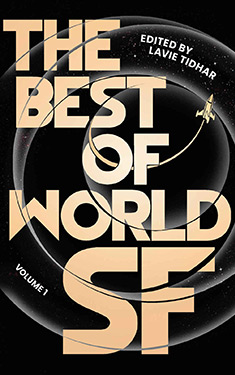
Added By: Administrator
Last Updated: spoltz
Venus Plus X
Synopsis
Charlie Johns has been snatched from his home on 61 North 34th Street and delivered to the strange future world of Ledom. Here, violence is a vague and improbable notion. Technology has triumphed over hunger, overpopulation, pollution, even time and space. But there is a change Charlie finds even more shocking: gender is a thing of the past. Venus Plus X is Theodore Sturgeon's brilliant evocation of a civilization for whom tensions between male and female and the human preoccupation with sex no longer exist.
As Charlie Johns explores Ledom and its people, he finds that the human precepts he holds dear are profane in this new world. But has Charlie learned all there is to know about this advanced society? And why are the Ledom so intent on gaining Charlie's approval? Unsettling, compelling, and no less than visionary, here is science fiction at its boldest: a novel whose wisdom and lyricism make it one of the most original and insightful speculations on gender ever produced.
Excerpt
The following text is quoted from the novel, Venus Plus X, by Theodore Sturgeon, Copyright ©1960. This text appears on pp. 161-175, in the current edition published by Vintage Books, which is available from Amazon and other booksellers.
Philo's Manifesto by Theodore Sturgeon from Venus Plus X
...you cannot be objective about this discussion. But try. Please try
You cannot be objective about it because you have been indoctrinated, sermonized, drenched, imbued. inculcated and policed on the matter since first you wore blue booties. You come from a time and place in which the maleness of the male, and the femaleness of the female, and the importance of their difference, were matters of almost total preoccupation.
Begin, then, with this--and if you like, regard it as mainly a working hypothesis. Actually it is a truth, and if at the end it passes the tests of your own understanding, you will see that it is a truth. If you do not, the fault is not with you, but with your orientation:
There are more basic similarities than differences between men and women.
Read through an anatomy manual. A lung is a lung, a kidney a kidney in man or in woman. It may be that statistically, women's bone-structure is lighter, the head smaller, and so on and on; yet it is not impossible that mankind had. for many thousands of years, bred for that. But aside from such conjectures, the variations permissible to what is called "normal" structure provide many examples of women who were taller, stronger, heavier-boned than most men, and men who were smaller, slighter, lighter than most women. Many men had larger pelvic openings than many women.
In the area of the secondary sexual characteristics, it is only statistically that we can note significant differences; for many women had more body hair than many men; many men had higher-pitched voices than many women... I call again on your objectivity: suspend for a moment your conviction that the statistical majority is the norm, and examine the cases, in their vast numbers, which exist outside that probable fiction, that norm. And go on:
For even with the sex organs themselves, variations in development--and here, admittedly, we approach the pathological--have yielded countless cases of atrophied phalli, hypertrophied clitorides, perforate rathes, detached labia... all, viewed objectively, reasonably subtle variations from the norm, and capable of producing, on an initially male or female body, virtually identical urogenital triangles. It is not my intention to state that such a situation is or should be normal--at least, not after the fourth fetal month, though up to then it is not only normal but universal--but only to bring out to you that its occurrence is easily within the limits of what has been, since prehistory, possible to nature.
Endocrinology demonstrates a number of interesting facts. Both male and female could produce male and female hormones, and did, and as a matter of fact, the preponderance of one over the other was a subtle matter indeed. Then if you throw that delicate balance out, the changes which could be brought about were drastic. In a few months you could produce a bearded and breastless lady and a man whose nipples, no longer an atrophied insigne of the very point I am making here, could be made to lactate.
These are gross and extreme examples purely for illustration. There have been many women athletes who could exceed in strength, speed, and skill the vast majority of men, but who were nonetheless what you might call "real" women, and many men who could, say, design clothing--traditionally a woman's specialty--far better than most women, yet who were what you might call "real" men. For when we get into what I might broadly term cultural differences between the sexes, the subtlety of sexual distinction begins to become apparent. What say the books:
Women have long hair. So have the Sikhs, whom some call the toughest breed of soldiers ever bred. So had the 18th-century cavaliers, and brocaded jackets and lace at throat and wrists as well. Women wear skirts. So does a kilted Scot, a Greek evzone, a Chinese, a Polynesian, none of whom could deserve the term "effeminate."
An objective scan of human history proliferates these examples to numbers astronomical. From place to place, and in any place from time to time, the so- called "provinces" of male and female rise like the salinity of a tidal river-mouth, mingling, separating, ebbing and regrouping... before your first World War, cigarettes and wrist-watches were regarded as unquestionably female appurtenances; twenty years later both were wholeheartedly adopted by the men. Europeans, especially central Europeans, were startled and very much amused to see American farmers milking cows and feeding chickens, for never in their lives had they seen that done by any but women.
So it is easily seen that the sexual insignes are nothing in themselves, for any of them, in another time and place. might belong to both sexes, the other sex, or neither. In other words, a skirt does not make the social entity woman. It takes a skirt plus a social attitude to do it.
But all through history, in virtually every culture and country, there has indeed been a "woman's province" and a "man's province," and in most cases the differences between them have been exploited to fantastic, sometimes sickening extremes.
Why?
First of all, it is easy to state, and easy to dispose of, the theory that in a primitive, primarily hunting-and-fishing society, a weaker, slower-moving sex, occasionally heavy with child and forced frequently to pause to nurse her young, is not as well fitted to hunt and fight as the fleeter-footed, untrammeled, hard- muscled male. However, it may well be that the primitive woman was not that much smaller, slower, weaker than her mate. Perhaps the theory confuses cause and effect, and perhaps, if some other force had not insisted upon such a development, accepted it, even bred for it, the nonparous females might have hunted with the best of the men, while those men who happened to be slower, smaller, weaker, kept house with the pregnant and nursing women. And this has happened--not in the majority of cases, but many times nevertheless.
The difference existed--granted. But it was exploited. It was a difference which continued to exist long, long after there was any question of hunting or, for that matter, of nursing. Humanity has insisted upon it; made it an article of faith. Again:
Why?
It would seem that there is a force which widens and exploits this difference, and, isolated, it is deplorable, even terrifying pressure.
For there is in mankind a deep and desperate necessity to feel superior. In any group there are some who genuinely are superior... but it is easy to see that within the parameters of any group, be it culture, club, nation, profession, only a few are really superior; the mass, clearly, are not.
But it is the will of the mass that dictates the mores, initiated though changes may be by individuals or minorities; the individuals or minorities, more often than not, are cut down for their trouble. And if a unit of the mass wants to feel superior, it will find a way. This terrible drive has found expression in many ways, through history--in slavery and genocide, xenophobia and snobbery, race prejudice and sex differentiation. Given a man who, among his fellows, has no real superiority, you are faced with a bedevilled madman who, if superiority is denied him, and he cannot learn one or earn one, will turn on something weaker than himself and make it inferior. The obvious, logical, handiest subject for this inexcusable indignity is his woman.
He could not do this to anyone he loved.
If, loving, he could not have insulted this close, so-little different other half of himself, he could never have done it to his fellow man. Without this force in him, he could never have warred, nor persecuted, nor in pursuit of superiority lied, cheated, murdered and stolen. It may be that the necessity to feel superior is the source of his drive, and his warring and killing have brought him to mighty places; yet it is not inconceivable that without it he might have turned to conquering his environment and learning his own nature, rising very much higher and, in the process, earning life for himself instead of extinction.
And strangely enough, man always wanted to love. Right up to the end, it was idiomatic that one "loved" music, a color, mathematics, a certain food--and aside from careless idiom, there were those who in the highest sense loved things beyond anything which even a fool would call sexual. "I could not love thee, dear, so much. loved I not honor more." "For God so loved the world, he gave his only begotten son..." Sexual love is love, certainly. But it is more precise to say that it is loving, in the same way we might say that justice is loving, and mercy is loving, forbearance, forgiveness, and, where it is not done to maximize the self, generosity.
Christianity was, at the outset, a love movement, as the slightest acquaintance with the New Testament clearly documents. What was not generally known until just before the end--so fiercely was all knowledge of primitive Christianity suppressed--was that it was a charitic religion--that is, a religion in which the congregation participated, in the hope of having a genuine religious experience, an experience later called theolepsy, or seized of God. Many of the early Christians did achieve this state, and often; many more achieved it but seldom, and yet kept going back and back seeking it. But once having experienced it, they were profoundly changed, inwardly gratified; it was this intense experience, and its permanent effects, which made it possible for them to endure the most frightful hardships and tortures, to die gladly, to fear nothing.
Few dispassionate descriptions of their services--gatherings is a better term-- survive, but the best accounts agree on a picture of people slipping away from fields, shops, even palaces, to be together in some hidden place--a mountain glade, a catacomb, anywhere where they might be uninterrupted. It is significant that rich and poor alike mingled at these gatherings: male and female. After eating together--genuinely, a love feast--and invoking the spirit, perhaps by song, and very likely by the dance, one or another might be seized by what they called the Spirit. Perhaps he or she--and it might be either--would exhort and praise God, and perhaps the true charitic (that is, divinely gifted) expression would issue forth in what was called "speaking in tongues," but these exhibitions, when genuine, were apparently not excessive nor frenetic; there was often time for many to take their turn. And with a kiss of peace, they would separate and slip back to their places in the world until the next meeting.
The primitive Christians did not invent charitic religion, by any means; nor did it cease with them. It recurs again and again throughout recorded history, and it takes many forms. Frequently they are orgiastic, Dionysic, like the worship of the Great Mother of the Gods, Cybele, which exerted an immense influence in Rome, Greece and the Orient a thousand years before Christ. Or chastity-based movements like the Cathars of the Middle Ages, the Adamites, the Brethren of the Free Spirit, the Waldenses (who tried to bring a form of apostolic Christianity into the framework of the Roman church) and many, many others appear all through history. They have in common one element--the subjective, participant, ecstatic experience--and almost invariably the equality of women, and they are all love religions.
Without exception they were savagely persecuted. It seems that there is a commanding element in the human makeup which regards loving as anathema, and will not suffer it to live.
Why?
An objective examination of basic motivations... reveals the simple and terrible reason.
There are two direct channels into the unconscious mind. Sex is one, religion is the other; and in pre-Christian times, it was usual to express them together. The Judeo-Christian system put a stop to it, for a very understandable reason. A charitic religion interposes nothing between the worshipper and his Divinity. A suppliant, suffused with worship, speaking in tongues, his whole body in the throes of ecstatic dance, is not splitting doctrinal hairs nor begging intercession from temporal or literary authorities. As to his conduct between times, his guide is simple. He will seek to do that which will make it possible to repeat the experience. If he does what for him is right in this endeavor, he will repeat it; if he is not able to repeat it, that alone is his total and complete punishment.
He is guiltless.
The only conceivable way to use the immense power of innate religiosity--the need to worship--for the acquisition of human power, is to place between worshipper and Divinity a guilt mechanism. The only way to achieve that is to organize and systematize worship, and the obvious way to bring this about is to monitor that other great striving of life--sex.
Homo sapiens is unique among species, extant and extinct, in having devised systems for the suppression of sex.
There are only three ways of dealing with sex. It may be gratified; it may be repressed; or it may be sublimated. The latter is, through history, often an ideal and frequently a success, but it is always an instability. Simple, day-by-day gratification, as in what is called the Golden Age of Greece, where they instituted three classes of women: wives, hetaerae and prostitutes, and at the same time idealized homosexuality, may be barbaric and immoral by many standards, but produces a surprising degree of sanity. A careful look, on the other hand, at the Middle Ages, makes the mind reel; it is like opening a window on a vast insane asylum, as broad as the world and as long as a thousand years; here is the product of repression. Here are the scourging manias, when people by the thousands flogged themselves and each other from town to town, seeking penance from excesses of guilt; here is the mystic Suso, in the fourteenth century, who had made for him an undergarment for his loins, bearing a hundred and fifty brass nails filed sharp: and lest he try to ease himself in his sleep, a leather harness to hold his wrists firmly against his neck; and further, lest he try to relieve himself of the lice and fleas which plagued him, he put on leather gloves studded with sharp nails which would tear his flesh wherever he touched it; and touch it he did, and when the wounds healed he tore them open again. He lay upon a discarded wooden door with a nail-studded cross against his back, and in forty years he never took a bath. Here are saints licking out lepers' sores; here is the Inquisition.
All this in the name of love. How could such a thing so change?
The examination of one sequence clearly shows how. Take the suppression of the Agape, the "love feast," which seems to have been a universal and necessary appurtenance of primitive Christianity. It can be unearthed by records of edicts against this and that practice, and it is significant that the elimination of a rite so important to worship seems to have taken between three and four hundred years to accomplish, and was done by a gradualism of astonishing skill and efficiency.
First of all, the Eucharist, the symbolic ritual of the body and blood of Christ, was introduced into the Agape. Next, we find the Agape better organized; there is now a bishop, without whom the Agape may not be held, for he must bless the food. A little later the bishop is traditionally kept standing through the meal, which of course keeps him separate, and above the others. After that, the kiss of peace is altered; instead of kissing one another, all the participants kiss the officiating priest, and later, they all kiss a piece of wood which is handed around and passed to the priest. And then, of course, the kiss is done away with altogether. In the year 363, the Council of Laodicea is able to establish the Eucharist as a major ritual by itself, by forbidding the Agape within a church, thus separating them. For many years the Agape was held outside the church door, but by 692 (the Trullan Council) it was possible to forbid it altogether, under the penalty of excommunication.
The Renaissance cured many of the forms of insanity, but not the insanity itself. When temporal and ecclesiastical authorities still maintained control over basically sexual matters--morals, and marriage, for example (although it was very late in the game when the Church actually performed marriage; marriages in England at the time of Shakespeare were by private contract valid, and by church blessing licit) guilt was still rife, guilt was still the filter between a man and his God. Love was still equated with passion and passion with sin, so that at one point it was held to be sinful for a man to love his wife with passion. Pleasure, the outer edge of ecstasy, was in the dour days of Protestantism, considered sinful in itself, wherever gained; Rome held specifically that any or all sexual pleasure was sinful. And for all this capped volcano produced in terms of bridges and houses, factories and bombs, it gouted from its riven sides a frightful harvest of neurosis. And even where a nation officially discarded the church, the same repressive techniques remained, the same preoccupation with doctrine, filtered through the same mesh of guilt. So sex and religion, the real meaning of human existence, ceased to be meaning and became means; the unbridgeable hostility between the final combatants was the proof of the identity of their aim--the total domination, for the ultimate satisfaction of the will to superiority, of all human minds.
Copyright © 1960 by Theodore Sturgeon
Reviews
Images
No alternate cover images currently exist for this novel.



















 Full Details
Full Details






